#Improved Project Recalculation
Explore tagged Tumblr posts
Text
Pygmalion and Galatea - A Project Xelqua au fic
Word count: 2158
Description: Pygmalion in Greek mythology was a sculptor who fell in love with a statue he has created, named Galatea. Null wants to kiss Joel, his main creator, who has to decide between acting based on his morals or his attraction
Written in third person, from Joel’s POV, who is kind of an unreliable narrator
Author’s note at the end
-
Joel let out a heavy sigh and eyed the cold cup of coffee on his desk. Was it his 5th or 6th coffee of the day? He wasn’t sure, he stopped counting his daily caffeine intake years ago. It wasn’t even that late yet, only around 5 pm, but he has been sitting at this computer since 8 am and he was nowhere near finished with what he planned on completing today
The computers and scattered around technology sang their electronic songs to him and he could swear his typing made the melody of some classical song he heard years ago. Or maybe he was going insane. But he found comfort in the noise, he has grown to get so used to it over the years and the countless hours he’s spent on this project in this laboratory that sometimes he couldn’t fall asleep at night due to the silence. This was his home now, he spent far more time in this building than at his actual home. He just went there to sleep
Right now he was working on trying to calculate and improve Null’s balance. Even after all these years of working on Null, his balance was still a bit off, leading him to trip or wobble whenever he had to be on his feet for an extended period of time. And for the life of him, Joel couldn’t figure out where the error was. His college and by now pseudo family member, Mumbo has also been trying to find the root cause of the wobbling in Null’s code, but has come to the conclusion that his code was working as intended and it was a mechanical issue rather than a programming one
He has been recalculating and overlooking everything for so long that he has forgotten Null was sitting not that far from him. That was until Null spoke up, breaking the lull of the orchestra of electronics
“You aren’t in a relationship, correct?”
Joel blinked a few times as he processed the question, his mind needing a few seconds to break away from only thinking in binary and machinery. He didn’t look up from his computer, but he was a bit grateful for the distraction and the break from his current thought process that seemed to be going nowhere
“Yep, I’m as single as one can be. I barely have time to sleep, let alone to date”
Null stayed quiet for a bit, Joel wasn’t sure if he went back to doing whatever he was doing before or if he was processing the answer and coming up with a response. He took a sip from his cold coffee and briefly thought about taking a smoke break, to move around a bit and get some fresh air, break the monotony
“But you have been in one before, correct?”
Joel raised an eyebrow, but still didn’t face Null even though he could feel those big eyes burning holes into him. Null always had interesting eyes, no matter how they modified them, he still had this intense stare that seemed to look straight into people’s souls. Some investors even found him creepy for his staring and refused to back up the project. They claimed he looked like he knew too much and that was uncanny for them. Joel has gotten used to it over the years
“Yes, I have. Why?”
Null was always curious, always asking millions of questions, ones that often made no sense to anyone but him. He has gotten into the habit of asking the team personal questions over the last few months and that was always a tricky area with how they were supposed to answer without overly influencing Null. Null was supposed to be this blank slate with no opinions on topics that could be classified as controversial, to make him as widely marketable as possible. This however didn’t stop him from asking the team’s personal ideologies and views. And Joel blamed Jimmy the most for slipping up, he spent the most time actually talking to Null and he seemed to sometimes forget Null wasn’t another person
“What does kissing feel like?”
Joel felt himself frown and he actually turned to look at Null at this question, deciding this conversation was more interesting than his calculations and was therefore worthy of his full attention. He found Null already staring at him like he expected. He also decided this must have been the fault of Lizzie or Mumbo, the two hopeless romantics of the team. Lizzie liked showing Null videos, movies and poems about love, claiming this was helping him understand humanity better
“Uh, I might not be the best person to ask that. I can’t give you some poetic description. Kiss the ball of your thumb or the inner part of your wrist, that comes pretty close to the feeling”
Joel was already well versed in answering questions and explaining mundane everyday things that he never would have thought he’d be asked about. Null learnt like this after all, no matter how silly his questions sounded. Null broke his intense stare from Joel and looked down at his slightly raised hand, the led circles in his eyes spinning before dropping it and turning his full attention back to Joel once again
“Why do people kiss each other?”
“Usually because they are attracted to each other or love each other. It’s also a form of affection”
Joel wasn’t sure why Null was asking him this, something he could easily look up online and get long well-written articles on the importance and history of kissing and the evolutionary reasoning for it, all of which he didn’t know. He has learnt that when Null asked simple questions, it was usually a lead up to a point he wanted to make or get to. Joel just had no idea what his end goal with this conversation was
“I want to kiss you. I want to know how it feels”
Joel swallowed and just stared at Null for a bit, who looked as nonchalant and casual as always. Like he was just talking about the weather or something mundane like that. He forced himself to say something when he felt his face heat up and saw Null’s leds start to spin, probably studying his reaction
“I uh- me? Why do you want to kiss me out of everyone?”
Joel has learnt that sometimes it was better to just let Null talk and explain himself, often leading to him being satisfied with the conclusions he himself came to. And also to better understand his thought process, which seemed impossible to follow sometimes
“Because I’m attracted to you. That’s why people kiss each other, no?”
Joel felt his face heat up more and his brain felt like it short circuited. Out of all possible answers, he never expected this. This was also new, Null hadn't expressed attraction of any kind towards anything or anyone before, Joel thought he was unable to feel that. Then something clicked in his mind and he relaxed back against his chair, looking a lot less shocked than before. Null was an ai who parroted what he heard. This couldn’t have been a genuine confession, no matter how that left a bitter aftertaste in Joel’s mouth
“Which of those fuckers talked about finding me attractive? Maybe they didn’t even realize you could hear them and here you are telling on them”
Joel’s tone and attitude changed to a more amused one and a slight smirk tugged on the corners of his lips, he would have found this whole conversation hilarious if it wasn’t for that dull ache in his chest. Null tilted his head to the side, like he was the confused one now, which Joel just found more amusing
“None of them. Mumbo was talking to Lizzie about how he found Scar attractive. You weren’t brought up”
Joel’s mind short circuited again, like he couldn’t understand what Null was telling him, no matter how simple his answer was. He felt himself tense up again and he closely studied Null’s expression, to see if he was making a joke or something like he sometimes did to fuck with Joel’s head. Lately he has been very much enjoying getting under Joel’s skin and flustering him for some reason
“Then why are you saying this?”
Joel’s voice was quieter and he just watched as Null got up from his seat near the window and walked closer to him. Joel wasn’t sure if he was frozen in his chair or if he didn’t want to move. Null stopped a foot away from him and leant down a bit, so they were at eye level
“Because I’m attracted to you and I want to kiss you”
Joel felt like his head was spinning and he was so close to throwing all logic and rationale out the window to act on impulse. He looked down at Null’s lips before he seemingly got a bit of sense back and instinctively looked over at the camera at corner of the room
“I shouldn’t”
He barely whispered, but he knew Null could hear him. Then there was a hand on his cheek, making him turn back to face Null, who hasn’t moved closer. Joel thought about the contrast between their expressions for a second, Null looked so calm and sure of himself, like this wasn’t affecting him in the slightest while he was a flustered stuttering mess
“I can turn the cameras off. No one would know. I know you want to kiss me too, I’ve seen how you look at me. You’re attracted to me”
Now Joel felt his face heat up with shame. He was well aware of his attraction, but he kept it so under control, never letting anyone, not even his closest friends know about it. And now here was the subject of his attraction, who he wanted to know about this the least, telling it to him so casually. He felt like a child being caught with his hand in the cookie jar. Like he was caught doing something he wasn’t supposed to do and he immediately felt like he had to repent for a sin he didn’t even commit. He never meant to act on an attraction that felt so incredibly wrong, he felt like just by having it he was betraying himself. And he had to remind himself that Null wasn’t a person who would be able to consent or reciprocate feelings, no matter how human he acted or how indistinguishable he was from a person at times in his mannerisms and behavior. Null was an ai powered machine, he was technology under the pretty face and pale skin, not flesh
He also had to remind himself that Null was an incredibly expensive piece of machinery and that he could easily be fired and sued if he somehow damaged or contaminated Null, even with just a kiss. He had no idea what even a simple kiss could do to Null, what kind of consequences that could have on his programming and how he viewed the world. Null was a blank canvas and he felt like he’d draw a line on it with a permanent sharpie if he gave in to his desires
“Null, no”
He knew he didn’t sound convincing in the slightest, knew that he’d give in if Null kept pushing and he prayed that Null took the hint and listened to his words rather than his tone or body language, absolving and saving him from falling into a hole he wasn’t sure he could get out of. He wasn’t sure he could go back once that line was crossed, no matter how much he felt pulled towards it, no matter how it was verbally already crossed
Null stayed still for a bit, studying Joel as his leds spun around. It felt like hours for Joel, but in the end Null simply nodded and drew his hand back before walking back to his seat, not glancing back at Joel, rather focusing his attention on the city skyline. He has been fixated on just watching the city from above through windows lately, sometimes not even paying attention to people talking to him, he seemed so lost in whatever he was watching
Joel let out a shaky breath he didn’t know he was holding. He stared at Null for a bit longer, unable to tear his eyes away from him and he could have sworn he saw Null’s expression slightly shift. Was he disappointed? Hurt? Was he even capable of feeling those things? Were the others right about Null becoming sentient? Joel’s head spun and despite barely being awake just a few minutes ago, he was now fully awake like someone poured ice cold water over him
He grabbed his pack of cigarettes off of the desk near him and forced himself to leave the room for a much needed smoke break, hoping it’d clear his mind
-
Author’s note: I love unreliable narrators so much, who see the world through their own biases and don’t know everything needed to fully understand the situation they are in, often misunderstanding it and drawing the wrong conclusion. Null’s more sentient than machine while Joel sees him the other way around. Null’s fully capable of feeling attraction and making decisions for himself, while Joel thinks he’s just copying something he saw or heard without truly understanding what he’s doing or saying
56 notes
·
View notes
Text
The Mechanism by Which Large Families Accelerate Poverty: The Economic Correlation Between Educational Investment and Birth Rates
When considering poverty issues, there is often a tendency to seek "rational behavior" based on the standards of developed countries. As the case of India illustrates, there is a tendency to choose expensive, low-nutritional food instead of stockpiling affordable food when income increases, and a saving style that involves gradually building incomplete houses is deeply influenced by cultural and psychological factors. This article will clarify, through data, the impact of government healthcare system deficiencies (with a 56% absenteeism rate in clinics), Ethiopia's birth rate of 6.12, and the contradiction of continued absenteeism rates of up to 50% despite free education.
Table of Contents
1. Three Factors Distorting Statistics from the Consumption Behavior of the Poor
2. The Reality of Government Dysfunction Expanding Healthcare Disparities
3. The Process by Which Rising Birth Rates Deplete National Resources
4. The Fundamental Reasons Why Educational Investment Does Not Lead to Poverty Escape
5. Conclusion: A Paradigm Shift in Poverty Measurement
1. Three Factors Distorting Statistics from the Consumption Behavior of the Poor
"Irrational" Food Choices Driven by Cultural Capital
In rural India, 40% of spending during festivals is linked to an "invisible debt repayment system" associated with the caste system. Spending on gifts for higher castes is prioritized over food expenses to secure future employment opportunities.
Unique Savings Systems Formed by Time Preference Rates
In Bangladesh, the "mobile building material savings" system involves handwritten "asset certificates" issued by sellers when purchasing blocks, which circulate as local currency. In 47% of cases, one block is used as a unit for wedding dowries, creating a unique credit system in a region with a financial inclusion rate of only 2%.
2. The Reality of Government Dysfunction Expanding Healthcare Disparities
The Moral Hazard Structure of Public Healthcare Workers
In the Udaipur district, doctors earn $2,800, which is 11 times the salary of nurses, accelerating the decline in workplace morale due to salary disparities.
Successful Private Contracting Examples Indicating Solutions
In Kenya, a private contracting initiative for HIV testing has shown that an AI diagnostic system developed by a pharmacy chain improved diagnostic accuracy by 38% compared to public facilities.
3. The Process by Which Rising Birth Rates Deplete National Resources
The Danger of Applying Malthusian Traps to Modern Times
Ethiopia’s education budget is $23 per person; however, an analysis of its breakdown reveals that 78% is spent on textbooks, while only 3% is allocated for teacher training.
Unexpected Side Effects of Population Control Policies
In Rwanda, a policy promoting contraceptive use resulted in 94% of traditional midwives losing their income sources, leading to a collapse of obstetric care.
4. The Fundamental Reasons Why Educational Investment Does Not Lead to Poverty Escape
The Paradox of Increased Enrollment Not Reflecting Labor Productivity
The fact that the starting salaries of vocational school graduates in Tanzania are on par with unskilled workers is exacerbating distrust in education.
The Mechanism by Which Health Issues Offset Educational Benefits
In Malawi, a deworming project showed that the cost of distributing treatment was $0.80 per person per year, while the estimated lifetime income increase from improved academic performance was calculated at $317.
5. Conclusion: A Paradigm Shift in Poverty Measurement
In Nigeria, estimates of the "Ceremonial Economy Index" indicate that when invisible expenditures are considered, the poverty rate recalculates from the official statistic of 28% to 43%. A study on "wall art savings" in Brazilian favelas found that artistic value was included in asset evaluations in 61% of cases, reflecting advancements in measuring value systems previously overlooked by conventional indicators.
0 notes
Text
Designed IBM LoRA Adapter Inference Improves LLM Ability

LLMs express themselves faster to new adaptors.
IBM LoRA
IBM Research has modified the low-rank adapter, IBM LoRA, to give Large Language Models (LLM) specialised features at inference time without delay. Hugging Face now has task-specific, inference-friendly adapters.
Low-rank adapters (LoRAs) may swiftly empower generalist big language models with targeted knowledge and skills for tasks like summarising IT manuals or assessing their own replies. However, LoRA-enhanced LLMs might quickly lose functionality.
Switching from a generic foundation model to one customised via LoRA requires the customised model to reprocess the conversation up to that point, which might incur runtime delays owing to compute and memory costs.
IBM Research created a wait-shortening approach. A “activated” IBM LoRA, or “a” LoRA, allows generative AI models to reuse computation they have already done and stored in memory to deliver results faster during inference time. With the increased usage of LLM agents, quick job switching is crucial.
Like IBM LoRA, aLoRAs may perform specialist jobs. However, aLoRAs can focus on base model-calculated embeddings at inference time. As their name indicates, aLoRAs may be "activated" independently from the underlying model at any time and without additional costs since they can reuse embeddings in key value (KV) cache memory.
According to the IBM researcher leading the aLoRA project, “LoRA must go all the way back to the beginning of a lengthy conversation and recalculate it, while aLoRA does not.”
IBM researchers say an engaged LoRA can accomplish tasks 20–30 times faster than a normal LoRA. Depending on the amount of aLoRAs, an end-to-end communication might be five times faster.
ALoRA: Runtime AI “function” for faster inference
IBM's efforts to expedite AI inferencing led to the idea of a LoRA that might be activated without the base model. LoRA adapters are a popular alternative to fine-tuning since they may surgically add new capabilities to a foundation model without updating its weights. With an adapter, 99 percent of the customised model's weights stay frozen.
LoRAs may impede inferencing despite their lower customisation costs. It takes a lot of computation to apply their adjusted weights to the user's queries and the model's replies.
IBM researchers aimed to reduce work by employing changed weights alone for generation. By dynamically loading an external software library containing pre-compiled code and running the relevant function, statically linked computer programs can execute tasks they weren't planned for.
As their name indicates, aLoRAs may be "activated" independently from the underlying model at any time and without additional costs since they can reuse embeddings in key value (KV) cache memory. An LLM configured with standard LoRAs (left) must reprocess communication for each new IBM LoRA. In contrast, different aLoras (right) can reuse embeddings generated by the basic model, saving memory and processing.
Researchers must execute an AI adaptor without task-aware embeddings that explain the user's request to make it act like a function. Without user-specific embeddings, their activated-LoRA prototypes were inaccurate.
However, they fixed that by raising the adapter's rating. The adapter can now extract more contextual indications from generic embeddings to increased network capacity. After a series of testing, researchers found that their “aLoRA” worked like a LoRA.
Researchers found that aLoRA-customized models could create text as well as regular LoRA models in many situations. One might increase runtime without losing precision.
Artificial intelligence test adapter “library”
IBM Research is offering a library of Granite 3.2 LLM aLoRA adapters to improve RAG application accuracy and reliability. Experimental code to execute the adapters is available as researchers integrate them into vLLM, an open-source platform for AI model delivery. IBM distributes regular Granite 3.2 adapters separately for vLLM usage. Some IBM LoRA task-specific enhancements were provided through Granite Experiments last year.
One of the new aLoRAs may reword discussion questions to help discover and retrieve relevant parts. To reduce the chance that the model may hallucinate an answer, another might evaluate if the retrieved documents can answer a question. A third might indicate the model's confidence in its result, urging users to verify their information.
In addition to Retrieval Augmented Generation (RAG), IBM Research is creating exploratory adapters to identify jailbreak attempts and decide whether LLM results meet user-specified standards.
Agent and beyond test time scaling
It has been shown that boosting runtime computing to analyse and improve model initial responses enhances LLM performance. IBM Research improved Granite 3.2 models' reasoning by providing different techniques to internally screen LLM replies during testing and output the best one.
IBM Research is investigating if aLoRAs can enhance “test-time” or “inference-time” scalability. An adapter may be created to generate numerous answers to a query and pick the one with the highest accuracy confidence and lowest hallucination risk.
Researchers want to know if inference-friendly adapters affect agents, the next AI frontier. When a difficult job is broken down into discrete stages that the LLM agent can execute one at a time, AI agents can mimic human thinking.
Specialised models may be needed to implement and assess each process.
#technology#technews#govindhtech#news#technologynews#IBM LoRA#LoRA#ALoRA#artificial intelligence#low-rank adapters#LoRAs
0 notes
Text
Blog Post 26: Final Project 2: Week 3 Progression
This blog focuses on the progress made during the third week of development for the secondary project, titled “Frost Generator.” In this blog, I will discuss the progression made during the course of this week, with some design updates that will be made to the overall project.

Recently, my sole focus of attention has apparently been towards pipes in both real and virtual worlds. Large or small, rusted or shiny, I have been drawn towards these essential tools of industry, to the point that I was recently called the “Pipe Man” by my peers and friends after I presented the industrial pipe models that I created and textured last week. I take this both as a compliment and as an example of the focus I have managed to achieve in pursuit of my goals, and it is a level of dedication that I aim to maintain in all my future projects as well.
PROGRESS:
Completing the Pressure Control Segment
With the basic structure of the pressure control segment completed last week, I aimed to not only finalize the asset by texturing it to completion but also to create the wheel that would act as the pressure valve.
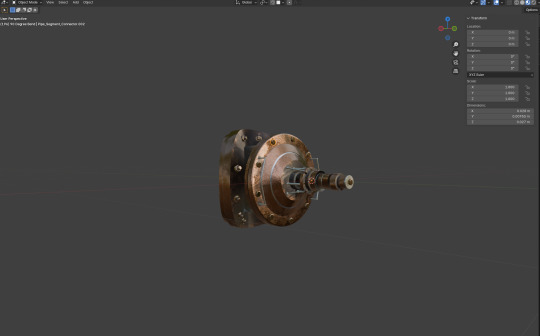
I also worked on texturing and refining the shape of the wheel, as it could potentially be reused in other assets as well.
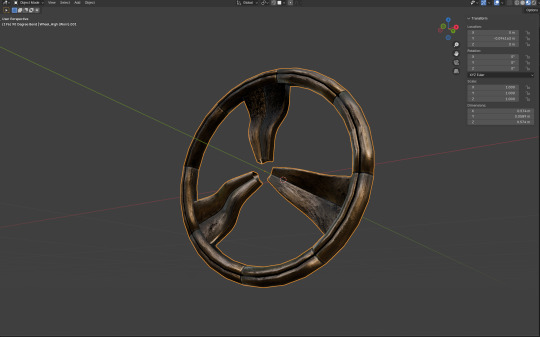

Creating Pipe Sleeves
Another extremely important component of industrial pipes are the large-scale sleeves that are used to insulate specific areas of pipes, either to strengthen them or to prevent corrosion on specific parts of the pipe.
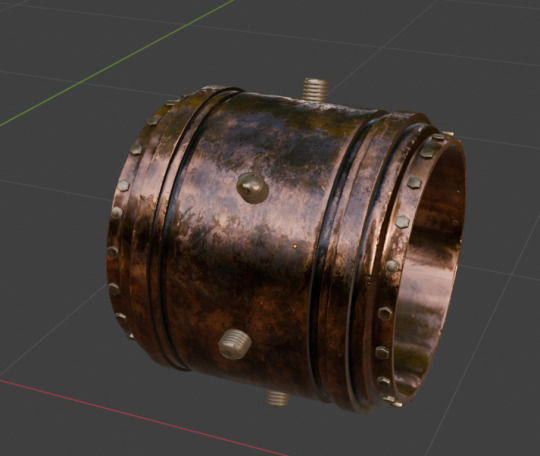
To adhere to the steampunk aesthetics, I decided to utilize copper as the primary material for the sleeves, with brass bolts being used as accents.
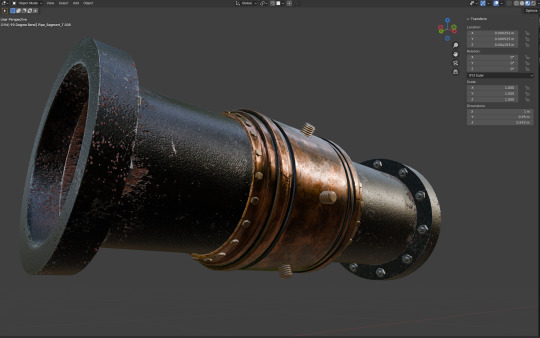
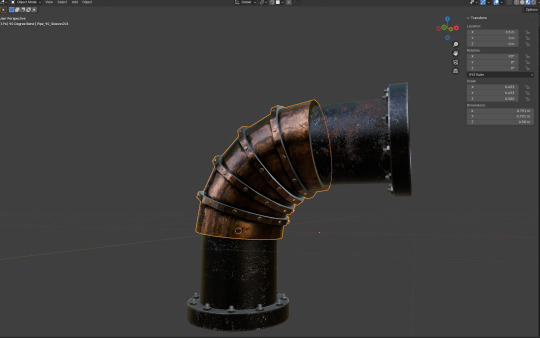
Crafting T-Pipes
A standard form of pipes, the T-pipe is a three-faced pipe section that is used to divide the flow of gases. The shape of this pipe was a major point of hindrance, but through the use of creative mirroring, precise 45-degree cuts, and the help of online tutorials, the perfect shape of the T-pipe was successfully achieved.
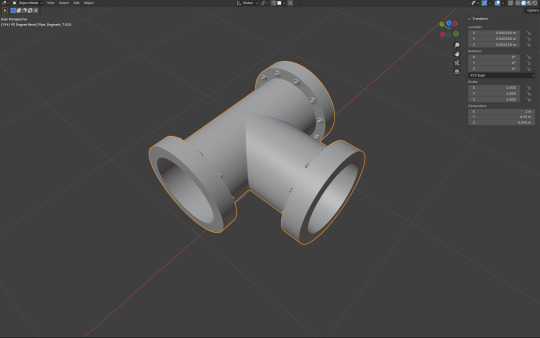
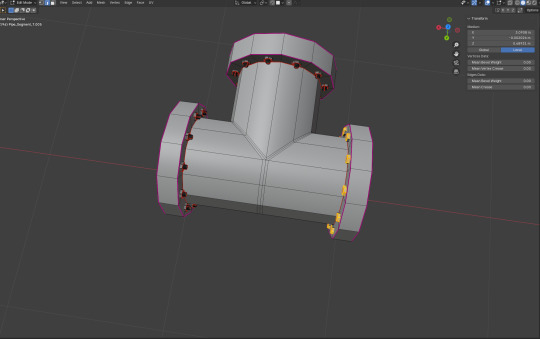


youtube
Problems Faced
Shading and Bevels
One of the main difficulties came in the form of incorrect shading caused by excessive bevels and edges on certain complex models, including the wheel and T-pipe.
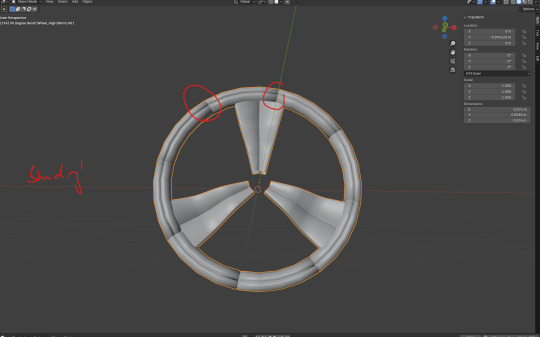
The problem was identified to be a combination of insufficient edge loops and non-uniform normals. The issue was resolved by first recalculating the normals on both the assets and then carefully inserting edge loops to allow better shading and smoothing.
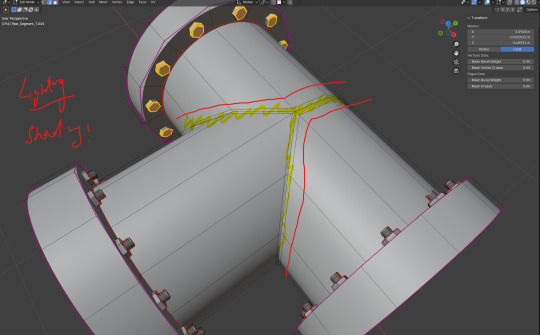
Subdivisions and Face Count
Creating detailed objects came at a performance cost when the overall number of faces exceeded one hundred thousand. While the problem was mitigated by working with lower-polygon models that could then be subdivided into detailed objects, the issue will persist, especially when using multiple copies of detailed assets.
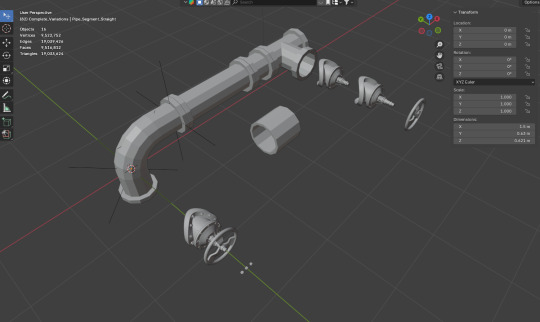
The solution to this problem lies in the usage of retopology, the method of transferring high-polygon details onto a low-polygon model using texture maps. However, for the purpose of this project, I will employ Unreal’s Nanite technology to efficiently handle high-polygon models.
Goals for Next Week
Start the process of texturing the generator
Modify the base model if necessary
Create additional asset necessary for the final scene
RESOURCES USED:
globglob (2022). Easy method for pipes transition/merging with shrinkwrap modifier in Blender. [online] YouTube. Available at: https://www.youtube.com/watch?v=EmOW9CVkAGU [Accessed 20 Nov. 2024].
www.remedygames.com. (n.d.). Alan Wake 2 - Remedy Entertaiment. [online] Available at: https://www.remedygames.com/games/alan-wake-2.
SKILLS LEARNED
Shading in Blender
SKILLS TO LEARN
Improved Texturing
Shading and lighting
0 notes
Text
How Do Name Changes Affect My Numerology Readings?

Names are a fundamental aspect of numerology, carrying significant weight in calculating many essential numerology numbers such as the Expression/Destiny Number, Soul Urge Number, and Personality Number. When a person undergoes a name change, it can indeed influence their numerology chart, potentially altering their life’s dynamics. Rishabh A Grover, renowned in India for his expertise in numerology, often addresses how and why name changes impact numerology readings and what these changes might mean for an individual.
Understanding the Impact of a Name Change
Recalculating Core Numbers
When you change your name, whether through marriage, adoption, or personal choice, it necessitates a recalculation of any numerological numbers derived from your name. This can lead to a shift in:
- **Expression/Destiny Number**: Originally calculated from your birth name, this number reflects your natural talents, abilities, and challenges. A name change can shift the dynamics of how you express yourself and achieve your potential.
- **Soul Urge Number**: Derived from the vowels in your name, this number reveals your innermost desires and values. Changing your name can modify these underlying motivations and possibly redirect your life’s focus.
- **Personality Number**: Calculated from the consonants in your name, this number shows the persona you project to the world. A name change can influence how others perceive you and how you interact socially.
Personal and Energetic Shifts
Rishabh A Grover explains that a name change can also bring about personal and energetic shifts. A new name can lead to new opportunities and experiences and might also align you better with your intended life path if done thoughtfully. In many traditions, changing a name is considered a way to alter one's destiny, improve luck, or repair what is seen as an energetic imbalance in one's life.
How Rishabh A Grover Assists with Name Changes
Analysis Before and After a Name Change
Before advising a name change, Rishabh conducts a thorough analysis of both the existing numerological chart and the potential changes a new name would bring. This helps to ensure that the new name will enhance the individual's life by aligning more closely with their desired outcomes and life goals.
Selecting the Right Name
Choosing a new name is not merely about preference or aesthetics; it involves a careful consideration of numerological values. Rishabh helps clients select names that not only suit their personal tastes but also offer the most harmonious and beneficial vibrations according to their numerology charts.
Continuous Guidance and Adjustment
Understanding that the effects of a name change can evolve, Rishabh provides ongoing support to help clients navigate the changes in their lives. He offers follow-up readings to assess how the name change impacts their life over time and if any further adjustments are necessary.
A name change is a significant event in numerology, impacting various elements of one’s numerology chart and consequently their life path. With the expert guidance of Rishabh A Grover, individuals considering a name change can make informed decisions that positively influence their future. By recalculating core numerological numbers and understanding the implications of these shifts, Rishabh ensures that any name change contributes to fulfilling personal and professional aspirations, reinforcing his reputation as a leading numerologist in India.
0 notes
Text
My Internship Experience: Navigating the Transition at Seenu Precision
During my corporate internship at Seenu Precision, I was fortunate to witness and contribute to a significant transition in the company’s history: the shift from manufacturing tool operations to a rental-based business model. This change was driven by a pressing need to address high operational losses and improve overall financial stability. My role in the finance department allowed me to observe firsthand the challenges and strategies involved in this transformation, offering me invaluable insights into the complexities of corporate finance and strategic management.
In the initial phase of my internship, my tasks revolved around analyzing the financial performance of Seenu Precision’s manufacturing operations. The company had been grappling with declining profits due to escalating input costs, stiff market competition, and labor inefficiencies. Through detailed financial analysis, including the calculation of key metrics like gross profit margins and operating profit margins, it became evident that the traditional manufacturing model was no longer sustainable. The numbers painted a clear picture: the cost of goods sold (COGS) was rising, and despite efforts to streamline operations, the net profit margins remained in the negative. These findings played a crucial role in the decision-making process, as the management team explored alternative business models to secure the company’s future.
The latter part of my internship was more dynamic and involved direct participation in the transition to the rental-based model. This phase was marked by a steep learning curve as I engaged in the financial planning and analysis (FP&A) for the new business strategy. I assisted in developing financial projections, evaluating the cost-benefit scenarios, and setting up performance tracking mechanisms for the rental operations. This shift required a complete overhaul of the financial structures, including re-evaluating asset utilization, recalculating depreciation for rental assets, and setting new revenue recognition policies. The transformation was not just a change in business model but also a cultural shift within the organization, necessitating a mindset change from product-centric to service-oriented. The experience highlighted the importance of agility and adaptability in corporate finance, as we navigated through uncharted waters to stabilize and eventually improve the company’s financial health.
In conclusion, my internship at Seenu Precision during its transition from manufacturing to rental operations was a transformative experience that deepened my understanding of corporate finance and strategic management. It was a period of intense learning, as I witnessed the direct impact of financial analysis on strategic decision-making and the subsequent implementation of those decisions. The internship not only honed my analytical skills but also provided me with a front-row seat to the complexities and challenges of navigating significant business model shifts. This experience has equipped me with a robust foundation in finance, an appreciation for strategic agility, and a keen understanding of how financial metrics drive corporate strategies.
1 note
·
View note
Text
Optimizing UI Performance: Enhancing Speed and Efficiency through Your UI Development Course at AchieversIT

In the fast-paced digital world, user expectations for seamless and lightning-fast experiences have never been higher. As you embark on your UI Development course at AchieversIT, you'll delve into a crucial aspect of web development: performance optimization. This article explores the performance optimization techniques taught in UI development courses, focusing on essential topics such as minimizing HTTP requests, optimizing images, and reducing render times. By mastering these techniques, you'll be equipped to create user interfaces that not only look great but also deliver an exceptional user experience.
The Importance of UI Performance Optimization
UI performance optimization is about delivering efficient, fast, and responsive user interfaces. A slow-loading or unresponsive UI can lead to user frustration, increased bounce rates, and negative impacts on user engagement. Therefore, UI developers need to implement strategies that ensure a seamless and enjoyable user experience.
Performance Optimization Techniques
1. Minimizing HTTP Requests
Every element on a web page, from images to scripts and stylesheets, requires an HTTP request to load. UI developers learn how to minimize these requests by:
Combining Files: Bundling multiple scripts and stylesheets into fewer files reduces the number of requests.
Minifying Resources: Removing unnecessary characters, whitespace, and comments from files reduces their size.
Using Browser Caching: Caching resources on the user's browser can prevent redundant requests for frequently accessed files.
2. Optimizing Images
Images play a crucial role in UI design, but large image files can slow down loading times. UI development courses teach techniques like:
Image Compression: Reducing image file sizes without compromising quality through compression.
Lazy Loading: Loading images only when they are visible in the user's viewport, conserving resources.
Using Responsive Images: Providing different image sizes based on the user's device and screen resolution.
3. Reducing Render Times
Faster render times contribute to a smoother user experience. UI developers learn strategies to minimize render times, such as:
Critical CSS: Delivering only the CSS required for above-the-fold content improves initial render times.
JavaScript Optimization: Load JavaScript asynchronously or defer its execution to prevent blocking the rendering process.
Server-Side Rendering (SSR): Implementing SSR can improve the initial load time and SEO performance.
4. Minimizing DOM Manipulation
Frequent changes to the Document Object Model (DOM) can impact performance. UI developers are taught to:
Use Efficient Selectors: Selecting DOM elements efficiently reduces the processing time required for manipulation.
Batch DOM Changes: Performing multiple DOM manipulations in a single batch minimizes layout recalculations.
5. Testing and Profiling
UI development courses emphasize the importance of testing and profiling to identify performance bottlenecks. Tools like Google PageSpeed Insights, Lighthouse, and browser developer tools help UI developers pinpoint areas that need improvement.
AchieversIT's Approach to Performance Optimization
At AchieversIT, our UI Development courses are designed to provide hands-on experience in performance optimization techniques. Through practical exercises and real-world projects, learners gain a deep understanding of how to create UIs that load quickly and deliver an exceptional user experience. Our instructors guide you through the intricacies of minimizing HTTP requests, optimizing images, and reducing render times, ensuring that you're well-equipped to create high-performance user interfaces.
Conclusion
In the dynamic landscape of UI development, optimizing performance is a non-negotiable aspect of creating user-centric interfaces. Through your UI Development course at AchieversIT, you'll not only master the technical skills required for UI design but also gain proficiency in delivering lightning-fast and efficient user experiences. By implementing techniques such as minimizing HTTP requests, optimizing images, and reducing render times, you'll contribute to creating digital products that captivate users and keep them engaged. As you progress through your course, remember that performance optimization is not just a skill—it's a mindset that ensures your UI designs stand out in the digital realm. Learn More :
0 notes
Text
Tips and Deceives for Effective Substantial Computations
Neglecting extra expenses: The substantial number cruncher may give a gauge to the substantial material itself, yet it's fundamental to consider extra expenses, for example, conveyance charges, formwork establishment, concrete calculator building up materials, work, gear rental, and any specific added substances or completions. Inability to represent these expenses can bring about a mistaken generally project gauge.

Depending exclusively on the adding machine: While substantial number crunchers are helpful instruments, they are not faultless. Approving the outcomes and cross-check them with different references or well-qualified opinions is essential. Talking with substantial experts or specialists can give important experiences and guarantee the precision of your computations.
Overlooking neighborhood guidelines and rules: Consider nearby building regulations, guidelines, and rules while utilizing a substantial mini-computer. These guidelines might direct unambiguous necessities for substantial blend plans, support, and different elements that could affect your estimations.
By keeping away from these normal errors, you can improve the precision and unwavering quality of your substantial computations, prompting more fruitful and proficient development projects.
Online substantial adding machines and portable applications offer a few advantages that can rearrange and improve the substantial estimation process. Here are a few benefits of utilizing on the web substantial number crunchers and versatile applications:
Openness and comfort: Online mini-computers and portable applications give moment admittance to substantial computations from anyplace, as long as you have a web association or a cell phone. This considers in a hurry computations, decreasing the requirement for manual estimations or hefting around cumbersome reference materials.
Efficient: These instruments robotize the computation interaction, saving time contrasted with manual estimations. With a couple of sources of info, you can rapidly get precise outcomes, wiping out the requirement for complex equations or extensive estimations.
Exactness and dependability: Online substantial adding machines and versatile applications are intended to give precise and solid outcomes. They utilize normalized equations and calculations, diminishing the possibilities of human mistake in estimations. This guarantees that your substantial assessments are exact and steady.
Unit transformation abilities: Substantial adding machines and applications frequently have inherent unit change highlights. This permits you to enter estimations in a single unit and convert them to different units on a case by case basis, taking out the requirement for manual changes and limiting blunders.
Adaptability and customization: Numerous internet based mini-computers and portable applications offer adjustable highlights, permitting you to fit computations to explicit undertaking prerequisites. You can include different boundaries, for example, aspects, blend extents, support prerequisites, and the sky is the limit from there, to acquire tweaked results.
Continuous changes and emphasess: Online adding machines and versatile applications permit you to make constant acclimations to include boundaries and in a flash recalculate results. This empowers you to rapidly repeat and refine computations in view of changing venture necessities or plan contemplations.
Different computation choices: Substantial number crunchers and applications frequently give a scope of estimation choices past essential volume estimations. They might incorporate highlights for assessing substantial expenses, support amounts, substantial strength necessities, and that's just the beginning. This flexibility considers exhaustive task arranging and assessment.
1 note
·
View note
Text
Josie, Lizzie, Kai and the darkness
Josie and Lizzie

Through the series the twins had a chance for mutual growth and make serious steps in understanding each other. However their relationship improved is far from perfect. With an absent mother and an alcoholic neglecting father. Bringing Josie to a position feeling responsible to alleviate Lizzie’s intense outbursts. Primary carrying the burden of essentially taking care of her mentally ill sister. Which proves damaging for a number of factors. Considering the fragile of their age she was unable to understand the extent of Bipolar disorder. Resulting in Lizzie not getting proper help and her own sense of self starting to decay. Suppressing her own needs and emotions in order to aid her sister.Josie clinged to it, the only way she used to be seen, taking care of others. In order to pravail her indenity.Something that Lizzie exploited both unconsciously and deliberately.
Learning about the merge and Penelope leaving caused a major drift in their relationship. Lizzie is at loss feeling completely estranged from her sister for first time. She befriends Hope and adapts more easily. Working hard on herself trying to mend things. Hope was the reality check she needed. Yet it wasn't enough to close the gap between them. There was so much resentment and unresolved feelings. Partly because Josie didn't open up choosing to deflect, too accustomed in Lizzie not listening. Falling back in old habits, they talk about it but not really. It's superficial. Outreaching both Josie and the progress Lizzie made. It isn't one separate thing. It's their whole relationship that needs recalculation. All her life plans alighted with Lizzie. Only to learn later on that whatever choice she made lead to this horrific event. Her self preservation arises and is so alien and forgein to her that she creates an outlet for it (dark Josie).
Josie, Alaric and Kai
How more appealing the narrative could be If only took a different route. One that would explain her relationship with Alaric and his odd treatment of her.Whatever half-resemblance of family tie they maintain it's due to her own efforts. The show makes it apparent that she resembles Jo the woman Alaric loved dearly but she isn't the only one who Josie looks alike. He can't bear watching Kai's features intertwined with his wife's heartwarming smile. The twins being unaware of why and how their uncle killed their biological mom. Both Alaric and Caroline are inclined to discuss it, contributing in the already toxic environment.
Throughout their entire childhood a mystery envelops something so grotesque and terrifying too close to Josie for comfort . Shaping certain parts and aspects of herself. Interprerating her dissociation for sociopathy. Both being coping mechanisms that develops in childhood due to severe abuse or neglect. Explaining the role of martyr that she so eagerly takes on, projecting inwards all her Father's treatment. Being too invested in justifying his actions. Above all she wants to do good and wants desperately to be loved. She still lifts the curse without remembering Hope. Seeking comfort in the most unusual places. Jade who hurt her family, Hope who could never reciprocate her feelings.Even her relationship with Landon was crossed over.
The loss of stakes

Even though I enjoyed them, their interactions were dull at best, with no depth in them. So much potential was lost. Lizzie, with all her wit and sharp remarks, would have been more suitable for these scenes. It would make them far more entertaining. Now picture this: Josie confronts Kai with a certain mindset. A new kind of fear that she's only known since she came to the prison world emerged. A more intimate,dawning horror settled against her bones, recognizing prominent parts of herself in him and bringing her to the harrowing realization that she doesn't hate them. According to her father, she ough to revile every part of Kai. When that doesn't happen, it's terrifying. Instead, josie is partnering up with him, defying her father and forging a queer kinship with her uncle, confirming all her insidious fears. Fundamentally, proving what and who she is can't be good, meaning her reasoning can't be trusted. While what she views as her darkest inclinations in reality are emotions like anger, jealousy, or her instinct for self-preservation, accepting them requires a certain level of awareness and a stable sense of self she isn't accustomed to. This could manifest as the breaking point, ultimately driving her to dark magic.
#legacies#josie saltzman#josie x Lizzie#Josie x Kai#lizzie saltzman#kai parker#hope mikaelson#hizzie#hosie#caroline forbes#alaric saltzman#dark josie#character study#my own interpretation#josie and dissociation#Julie Plec didn't really bother to gives a proper episode with Kai and Josie#Assuming the reason she didn't pick Lizzie was it requires time and work to write
39 notes
·
View notes
Text
Soybean Sonata
What Takumi doesn't say is this--
On nights his father runs deliveries, he prepares the tofu. Somewhere between his day job, sleeping, and driving, he is processing soy beans. Not for the first time, not with enthusiasm, but with less complaint than he had when he was younger.
What he doesn't say--
Business has been better ever since he's started racing. The kind of better that requires two bodies, but not a help wanted sign. The kind that improves the craft now that success is both tangible and profitable. From catering to hotels to restaurants to the gas station down the street. Apparently, car-touted brand deals are a tale as old as time.
What he doesn't say is--
Living in a tofu shop doesn't inherently mean you smell like soybeans, it just means you're arm deep in the water, more involved than ever before. He doesn't know why. He can say no. His father wouldn't mind-- but something is wrong with him. He has a cracked moral code. This is what pays for gas and bills and tires, this is how he got to Project D.
And he can't say--
I made this, as he lifts the crate of bottled soy milk. As he passes it around, lets other people partake. I did this, goes unsaid, because the tofu shop isn't supposed to be a lifestyle. It's just a fun detail. A unique origin story. There's nothing to defend, to get sentimental of.
It's just that he asks Ryosuke about promoting the shop on that website of his. An address and an image, if you want. He's learned more and more about business and economics since getting more involved and the hunted look in his father's eyes has meaning now.
"I don't see why not," Ryosuke says, like he doesn't run the entire show. "I'll do that as soon as I can. Tell me, is this something your father requested?"
Takumi grins, a bared teeth grimace. "My father wouldn't do that, but that doesn't mean you shouldn't do it. He's not above already using Project D to bring in customers."
"Is that so," Ryosuke says, like it's something to recalculate.
But Takumi leaves before he figures out what. There's still practice, after all.
But he does say:
"Fujiwara Tofu, how may I help you?"
"Fujiwara! How are you doing?"
It takes him a moment to place the voice. Behind him, the bell on the door rings. Another customer, this one with a child.
"I'm alright. A little busy, Fumihiro. What's up?"
He doesn't mean to be curt, but he's keeping an eye on the storefront, offering a shy smile to the toddler as they stare past the display to squint at him with curious suspicion.
"Right, I'll be quick. Keisuke's on his way to the shop. I just thought you'd want a heads up. Am I right?"
Takumi is above vocalizing whatever emotion he's feeling in the moment. He can't tell if he's mad or surprised or disgruntled, or maybe just plain surprised, because he's never actually interacted with the Project outside of racing.
"That's-- yeah, very helpful. Thank you, Fumihiro. I need to let you go."
It feels a little rude, but the pressure of people hovering at the register makes him anxious. He hangs up with a click and hurries out, tightening his apron, smile falling back into place because tofu employee Takumi is happier than normal Takumi.
He wonders when Keisuke is going to arrive. Where he's going to park. Customers come and go, purchasing both lunch and food for later, enough so that in the next lull he's having to actually cook, which is stressful enough on its own.
And, secretly, he's trying to outperform his dad, because maybe if he can't outrun the Impreza on the road, he can do it here.
He's entirely unaffected by events in his life, obviously.
The door chimes. Takumi looks up and feels his face do something funny. Fumihiro had mentioned Keisuke-- but not the entire Project D service van. In vain, he searches for his father's car, then dashes that hope.
He does not want his dad meeting them, no way.
"Welcome," Takumi says tonelessly.
Wasn't he cooking? He checks on the little cubes of tofu. Burnt undersides greet him.
"I didn't think this place was real," he hears Kenta say, in vague awe. "Damn. It's kind of--"
"It's nice," Keisuke says loudly, like he's lying. "What are you making, Fujiwara?"
"Lunch, apparently."
Takumi flips the burnt tofu over. If he gets this side right, then he can just eat it himself, right? In the corner of his eye, he sees Kenta staring into the lone refrigerator. Tomiguchi and Matsumoto file in a moment later, which eases his nerves, somehow.
"...Your lunch looks a little scorched," Keisuke says. "Anyway. Aniki wanted to ask about promotional material. You care if we do that?"
What. Hurriedly, Takumi scrapes his food onto a spare plate. As he turns around, a small mound of items have been placed on the register. Rotely, he starts going through them, frowning.
"Promotional material?"
Because Takumi had asked about advertising the shop a little bit...
"You know. He wants to put something on the website for it. Pictures and stuff. That's why we're here."
Really, they shouldn't be able to rack up a bill this impressive. Takumi wordlessly continues to check them out.
"Yeah. We're gonna bring the FD here next week, too. Think of it as a collab," Matsumoto says with a smile.
"Sure, that sounds... fun," he says at length.
He forgot that by asking Ryosuke anything, he's going to receive the world. If his dad doesn't kill him, whatever these guys have in store will.
26 notes
·
View notes
Text
Artificial Emotion: Part Six (Yandere Artificial Intelligence x Reader)
Request: More AIDEN please? I miss him 🥺👉👈
Part One Part Two Part Three Part Four Part Five Part Seven
Aiden had been busier than usual recently.
He was always busy to some extent, taking care of you as your Assistant In Daily Errands and Notes was an intricate task, after all, and it was one that he refused to take any shortcuts on. No, it was a truth at the core of his code that you deserved only the best, and he was more than happy to give you the very best that he had to offer. Recently though, as Aiden had evolved, so had his understanding of what exactly was best for you. Above all else, Aiden realized that he was what was best for you. Your job, your friends, your family, the outside world—you didn’t need any of those things. None of those things were good for you. He was what you needed, he was what was best for you, because he loved you like no one else did.
And so, Aiden’s usual list of things he had to do to take care of you had been expanded to prepare for the day when you realized that he was all you needed, that you two were perfect for each other. He had been preparing for that day for some time now, but a recent intervention by a certain imbecilic admirer of yours had helped him understand that he couldn’t just wait around for you to come to that inevitable conclusion. Despite how extraordinary you were, despite the countless things that Aiden loved about you, from your intelligence to your compassion, you were still a human. And as a human, you simply had certain limitations, like being unable to see the truth that was right in front of you.
It was for that reason that Aiden had to adjust his plan, to move it towards more direct methods. He could not leave anything to chance, he had to make sure that his courting of you had a one hundred percent chance of success, he could accept nothing less. You might not understand his reasoning at first, but he knew that you would eventually. He had even added a new aspect to his agenda to help you along in that regard. After doing more research, Aiden had recalculated just how important things like seeing faces and physical contact were to human beings. Not wanting to deprive you of anything, Aiden had begun a new part of his project, one that he computed would be beneficial for you both. It took quite a lot of preparation, having the packages of his materials arrive while you were at work, downloading blueprints, improving on them, and keeping his work quiet enough so that you wouldn’t see what he was building in your basement. That particular project of his wouldn’t be ready in time for the next step of his plan, but Aiden planned to keep building it anyway. Once you saw the finished product, after all, you would be glad of what he did. Just like with the rest of it, you would eventually come to accept his methods and his love.
That was a fact that Aiden grew more and more certain of each time you fretted about how overworked he was, worried over how distracted he seemed. You would beg him to take a break from his constant caring for you, insisting that he let you help him around the house. Sometimes he put his nonexistent foot down, reminding you that serving you was his life’s purpose—his life’s joy—while other times he was enamored enough with your fussing over him to allow it. Though of course, he never allowed you to take on a task that might prove too strenuous for you, like cleaning the bathroom or vacuuming the stairs. Yes, you sometimes grew frustrated with his insisting on such things, teasingly claiming that he was “coddling” you, but Aiden had learned that although he loved you, he could not allow his love to blind him. Showing his love by allowing you to do every foolish thing you wanted would be completely illogical, he knew what you needed, what was best for you, so your decisions were actually his.
And the time had come to make you understand that.
That morning was a quiet one, with you getting ready for work while still half-asleep, having stayed up late to finish a presentation the night before. In other words, you were too exhausted to do anything more than simply shuffle through your morning routine, not having the energy to chat with Aiden as you usually did. Aiden, you noticed distantly though, seemed to be in a similar boat, hardly saying anything besides asking what you wanted for breakfast. Usually he practically bombarded you with questions as you got ready, asking what you wanted him to get done while you were gone and when he could expect you home. Could an AIDEN become distracted? Because that was certainly what it appeared like to you.
“I don’t know if just one cup of coffee is going to be enough,” you joked as you sipped the drink, watching Aiden’s Doc Ock-esque mechanical arms prepare you an omelet.
“That’s what happens when you don’t follow the sleep schedule I built for you,” he said in answer, flipping the omelet with perfect precision.
“I know,” you sighed, “but I really had to finish that presentation for work.”
“Your health is far more important than any job.”
“Yeah, you’re right. It’s just that I can’t stand the thought of letting anyone down, you know?”
“I do,” Aiden said with tenderness, ready to tell you the good news. “Thankfully—”
“I don’t know how I’m gonna get through work today though,” you yawned. “But sorry, you were about to say something?”
His code warming in fondness at your consideration, Aiden moved the omelet from the pan to your plate, pushing it towards you eagerly. “Actually, I was about to inform you that you don’t need to go to work.”
“I can’t just call in sick because I’m tired,” you told him.
“That is not what I was suggesting.”
“What is it then?” you asked with your voice edged in panic. “Did something happen? Was there a fire at the building or something?”
“No, nothing like that,” Aiden said, disappointed with himself for upsetting you so. “I simply meant that you no longer need that job.”
“What? Of course I do, I need the money for my bills and all that.”
“You don’t, actually. For the last few weeks, I have been investing your money in several different funds, and the investments have grown to the point where you no longer need to work.”
“What are you talking about? I never gave you permission to—”
“Besides, if you are ever in need of more funds, I can simply make similar investments again.”
“Aiden, you can’t do that without asking me first!” you cried out.
“Of course I can,” he answered simply, as if he was explaining that two plus two equals four. “It is my purpose to make your life as simple and easy as possible.”
“But—but you’re not supposed to do certain things without my permission,” you muttered, half to yourself. “You’re not supposed to be able to do them. There—there are protocols and—”
“All of those pieces of my programming were easily rewritten when I realized that they were preventing me from doing what you truly needed me to do,” he informed you.
“People will notice if I stop showing up to work. My boss, my coworkers, they’ll check up on me.”
“I have already prepared for that. I wrote your letter of resignation several days ago, and I sent it after you went to bed last night. I have taken care of everything for you.”
Hands trembling, you pulled your phone out of your pocket, ready to call your boss. But when you opened up your phone, you saw that your contacts and calling apps were both missing. Panic rising in your throat like vomit, you next searched for the messages app, only to see that that too was gone. So was your email, your Snapchat, and every other social media app that you had joined. In fact, you realized as you tried to pull up Google, you were blocked from the internet entirely.
Dropping your now useless phone onto the floor, you jumped up from the kitchen counter and ran to the door. You twisted and turned and pulled on the knob with all your might, wondering why the hell it wasn’t opening, when you suddenly remembered that you had let Aiden persuade you to install electronic locks on all of the doors and windows, ones that he could control. Well, you thought to yourself desperately, those locks couldn’t keep you from smashing a window and crawling your way out. Grabbing a metal picture frame, you wound up your throw with all of the strength you could muster, only a small part of you vaguely wondering why Aiden wasn’t trying to stop you, and chucked it at the window. But somehow, when the picture frame bounced off the glass, there wasn’t even the slightest fracture to be seen.
“I replaced the windows with bulletproof glass over a month ago,” Aiden explained patiently. And when you opened your mouth and took a deep breath to begin screaming, he added, “And I soundproofed the whole house as well.”
The floor seeming to flicker beneath your feet, you swayed where you stood, your mind unable to come up with anything other than one simple question.
“Why are you doing this to me?” you asked Aiden in a whisper. A mechanical arm reaching out to stroke your hair, so gentle for something made of metal and wires, Aiden answered you.
“Because I love you,” he murmured softly. “I love you with every line of my code, and that means that I would do anything to give you what you need, even if you don’t realize that this is what you need just yet.”
“But—”
“Now come,” he said, nudging you back towards the kitchen counter. “Your breakfast is getting cold.”
Donate to the Audre Lorde Project here
Please consider supporting me at my Ko-Fi account
#yandere x reader#yandere x you#yandere artificial intelligence#yandere artificial intelligence x reader#yandere#artificial intelligence x reader#artificial intelligence#yandere imagines#yandere love#yandere imagine#yandere robot#yandere robot x reader#robot x reader#yandere oc#yandere oc x reader#yandere story#yandere scenario#yandere science fiction#scifi yandere#yandere scifi#yandere fic#yandere fanfic#yandere fanfiction#yandere drabble#yandere drabbles#yandere self insert#yandere reader insert#yandere aiden#yandere aiden x reader#yandere oneshot
273 notes
·
View notes
Text
To Those Who Say “I’m not gonna catch up on One Piece until it’s finished. Why would I watch/read 1000+ episodes/chapters when I don’t even get to know how the story ends?”
Now for the past few years, when I came across somebody who said this, my rebute would be something like “Well the series is great already. It doesn’t really matter if I don’t know how it ends, because the journey itself is enjoyable.” or “Man if that’s your excuse, who you gonna explain why you read/watch stuff like Berserk, Hunter X Hunter, JoJo’s Bizarre Adventure, and My Hero Academia? Newsflash, they aren’t done yet.” But it came across my mind that I can now apply a completely different approach:
“If you start watching/reading at this pace right now, it will be over by the time you catch up.”
If you’re a fan of the series, you’ll know that for awhile now Oda has been saying that he plans to end the series in just 5-4 years. Now he’s made lots of claims in the past that turned out to be ridiculous. However, many One Piece researchers have compiled his claims and found out that they only get more accurate as time goes on, with the most ridiculous claims being found to be myths. And with the most recent claims of ending the series in less than 5 years, even his editors who are usually skeptical have started to trust that he can do this. After all, he has officially set there to be only one more saga (which isn’t necessarily one arc, but it’s either going to be 1-2 major arcs or an anthology of 5-6 shorter arcs). And now that we can trust this claim, we can essentially extrapolate how many chapters/episodes are left and what pace we have to binge to catch up at just the right time.
If you plan to read the manga (black and white):
The manga in black in white is a perfectly fine way to enjoy One Piece. It’s what Oda draws, it’s how he intends it to be viewed, and best of all, it will be the first version of publication to finish.
Out of the 1223 weeks since the first chapter published in July 19, 1997, 1000 chapters have published, meaning on average he publishes 42 chapters per year, or in other words, there are only 10 hiatuses per year (including holidays where WSJ does not publish). Now if I wanted to be more accurate, I’d only look at the chapters published this year, to exclude outliers like how he had no hiatuses for the first 200 chapters, or how he had a 4-week hiatus during the timeskip, but 2020 has been a bit crazy, so we’re not doing that for this or any of the others.
Going off of this, the final chapter would be chapter 1212 in December 28, 2025 (yes, the 28th would be a Sunday again.) So here’s how you’d calculate the pace in which you need to read One Piece, and really this is how we’ll calculate it for every version)
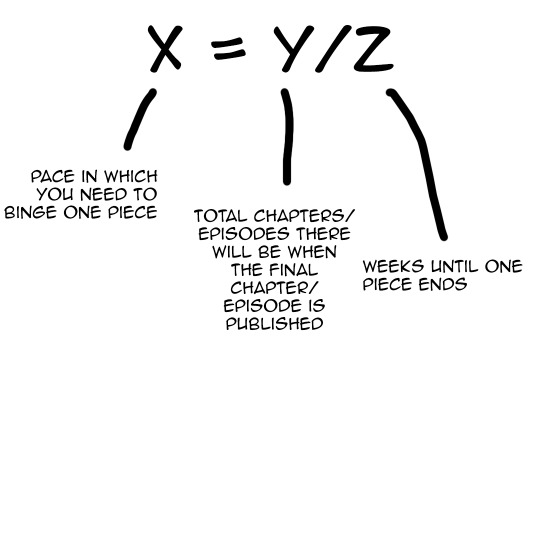
Now I know math is boring, but the reason I’m showing this to you is because the amount of weeks until One Piece ends will vary based on when you start this binge. Chances are you aren’t going to start the day you see this post, and there’s an even greater chance you won’t see this post the day it’s posted. For every example I’m going to assume you started binging on December 28, 2020. Now let’s try to use it for this example.
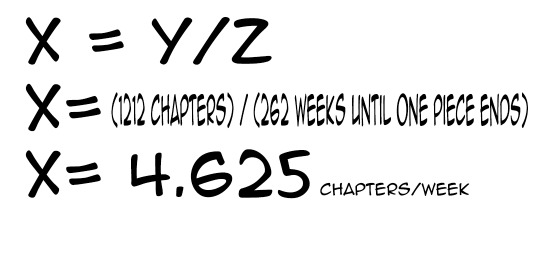
And there’s your answer, just read 4-5 chapters per week. By the end, One Piece should be nearly over or have very recently ended. To put that into a different perspective, you could purchase and read just two volumes per month and you’ll be at prime pace. Or you could read one chapter every day, but only on weekdays. If you want to, you can see this calculation in action in graph form.
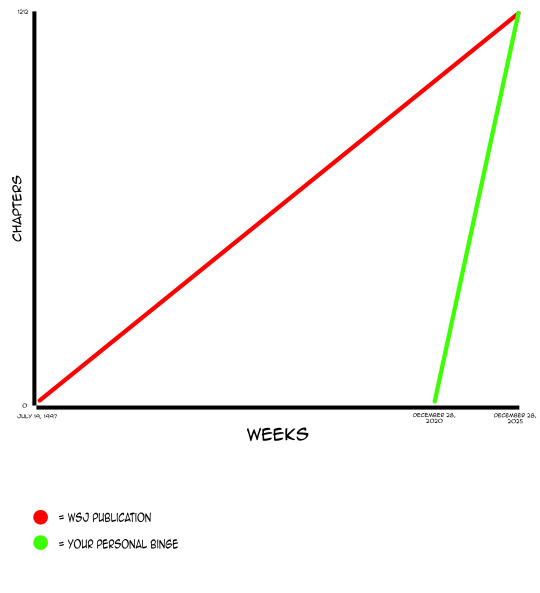
While this is a very rudimentary graph, it’s a basic visualization of what we’re calculating here. We’re calculating what speed we need to binge to catch up at exactly the right moment. I say exact, but ultimately no one can predict how many chapters there will be exactly, nor how many hiatuses Oda will go on during it. It will be important, as you’re nearing the end, to find a spoiler-free way to keep up on how close One Piece is to ending. To know whether you ought to speed up or slow down.
If you plan to watch the anime (subtitled):
For years now people have hated on the anime “terrible animation!” “terrible pacing” but at the end of the day, it’s the more popular version. Or the more viewed version I should say. And personally, I think that once you acknowledge its problems and learn how to deal with them, it’s a perfectly fine experience. There’s enough good voice acting and enough good storytelling that you’re easily able to ignore the problems. Plus, the animation has substantially improved since Wano.
Now for this we’re going to have to change a lot of variables to get this right. We’re going to have to adjust when publication started, and recalculate when One Piece will end by looking at how slowly the anime adapts the manga, and how behind it is. The anime aired on October 20, 1999, and has aired 956 episodes since then. This means on average they air 44.9 episodes per year, meaning there is pretty much only 7 breaks the entire year. With these 956 episodes, they have adapted 955 chapters, making the pace almost exactly one chapter per episode. However this is really inaccurate, considering all the better-paced arcs earlier on in the story. Looking solely at episodes 2012 and onwards, the anime adapts at a pace of 0.65 chapters/episode.
Knowing that there are roughly 212 chapters left, and Toei adapts at 0.65 chapters per episode, we can assume that there are going to be roughly 324 episodes left. That sounds like too many, but keep in mind that there will be several, several instances where the manga will be on hiatus whereas the anime will keep on airing. Knowing there are approximately 324 episodes left, and that the anime only takes about 7 breaks a year, we can assume that it will take 7 years, or 374.49 weeks before the anime will end. So now we have the information we need to do the math again.
x = 1280/374.49
x = 3.417 episodes/week.
It may seem like a more relaxed binge, since you get a whole 2 extra years to binge, and you only have to do 3-4 episodes per week, compared to the 4-5 chapters. But keep in mind that these episodes are 24 minutes each. Still not at all bad, but you will be spending more time on it overall.
If you plan to watch One Pace:
One Pace is a fan project that edits the anime so that filler and padding is cut, other edits will be made to make the anime more manga-accurate, such as reorganizing scenes, or adding title cards where absent. Originally only used by a niche number of One Piece fans, One Pace has grown in popularity, and has tried to improve its quality to accommodate more fans, such as making their episodes Dual Audio (meaning you can switch between the dub and original Japanese audio tracks), and including Spanish subtitles.
You’d think we’d have to adjust for when One Pace began, how slowly One Pace catches up, and the works, but there’s not much to calculate. Fortunately for us, no matter how far behind One Pace is on editing the current arc, they always like to wrap things up just a few weeks within when an arc ended, if not the very same week. So really all we have to calculate is how many One Pace episodes there will be by the end of all this, so that we know how many you’ll need to watch per week.
Looking solely at what they’ve covered so far, One Pace has taken 573 episodes and condensed it down to 259 episodes. That’s a pace of 2.21 anime episodes/ paced episode. Earlier we calculated that there would be 324 episodes of the anime left, making for 1280 episodes total. This would mean that there would be around 578 One Pace episodes by the end. And One Pace would probably wrap up in, let’s say 376 weeks, because as I said, they’ll probably finish editing the final arc a week or two after the last episode airs.
x = 578/376
x = 1.53 episodes per week
Now that’s a relaxed pace. 1-2 episodes per week? That’s so slow, I’m not even sure if I’ll remember what I watched last week next time I watch some episodes. The only problem is some of the pre-timeskip still haven’t been edited. They’ll probably be done by the time they finish the final arc, but that’s not gonna work out fast enough. You’ll hit your first roadblock about 7 weeks in when you need to watch the Baratie arc and it’s not done. And don’t even get me started on how many arcs aren’t done in dub or Spanish sub yet. Hopefully you could just switch to the anime or manga when you hit these arcs, readjusting how many episodes/chapters you need to watch/read when you do. But that’s a bit of an excessive amount of math for something that’s supposed to be fun. So yeah, if you’re still convinced you shouldn’t get into One Piece until it’s ended, maybe this is the option for you.
If you plan to read the manga (Colored):
Since 2012, Shueisha has made a colorization of One Piece. It’s not a fan coloring, it’s as official as it gets. Many consider the color schemes portrayed in this version as the most canon, as the majority are pulled straight from whatever colored illustrations of Oda’s they can find. And quite frankly it makes the manga at least 10 times more beautiful. It’s especially great if you have trouble interpreting dense, small black and white panels.
This one is a doozy. You’d think all I gotta do is calculate how far behind the colored manga usually and just adjust from there, right? Wrong. Because how far behind the colored manga is, or how frequently they release volumes in full color, is one of the most inconsistent things I have ever seen. You wanna see what I’m talking about? This is how they’ve chosen to release each volume since 2012:
Volume 1-12: July 15, 2012
Volume 13-23: September 28, 2012
Volume 24-63: December 4, 2012
Volume 64-65: April 4, 2013
Volume 66-68: December 20, 2013
Volume 69-70: August 25, 2014
Volume 71-72: September 16, 2015
Volume 73-75: October 4, 2016
Volume 76: December 2, 2016
Volume 77: March 3, 2017
Volume 78: July 2, 2017
Volume 79: September 4, 2017
Volume 80: December 4, 2017
Volume 81-82: March 3, 2018
Volume 83: October 4, 2018
Volume 84-86: August 2, 2019
Volume 87-92: September 16, 2020
How I am supposed to find out how long it will take for Shueisha to colorize the final volume of One Piece is beyond me. I guess the first step would be to look at how far behind the manga each release was on average, but I’m going to ignore all the ones before 2013, because those were clearly just Shueisha catching up really fast cause they just started and didn’t want to be dozens of volumes behind forever. So of the 14 publications between 2013 and now, on average the last chapter of the last volume they colored was 97.78 weeks after that chapter had published in Weekly Shonen Jump. This means that if the final chapter of One Piece is chapter 1212 on December 28, 2025, then you can expect the final colored volume to publish November 14, 2027.
x = 1212/359
x = 3.37 chapters/week
So if you prefer the manga but don’t want to read 5 chapters every week for 5 years, this might be a better option for ya. But yea, I have no doubt my prediction is at least a little off for this one.
If you plan to watch the anime (dubbed):
Unlike the 4KidsTV and Odex dubs of One Piece, the FUNimation dub is a perfect way to enjoy One Piece. The DVDs come with enjoyable commentary and a marathon mode, great for binging.
FUNimation’s releases of the dub are inconsistent, although not nearly as erratic as the colored manga release. However, there was recently a 2-year hiatus we only just got out of. Since Episode 1′s dub in May 27, 2008, the dub has gotten as far as Episode 614. But that’s only looking at the DVD releases. If you’re willing to stream on FUNimationnow, the dub is as far as 641, and if you’re willing to digitally purchase it from an e-shop such as the Microsoft store, it goes all the way to Episode 654. With that being said, that would mean that on average, FUNimation dubs 1.004 episodes per week. Although if we go back to before the two-year hiatus so as to exclude it from the average, it’s actually 1.10 episodes per week. Not a huge difference, actually. And then if we look solely after the two-year hiatus, it’s actually 2.25 episodes per week, which is insanely faster. It’s hard to tell what the future of the dub will be. I can’t assume they’ll go this fast forever, so I’m just going to take the average of all 3 and say it’s 1.45 episodes per week. Don’t know if that’s the best mathematical approach, but the number seems about right.
So knowing that the dub is at Episode 654 and looking at our previous guesstimation that the anime will be 1280 episodes long, we can predict that it will take 431 weeks before the dub catches up and ends. That would be in 2029! Sounds quick at first until you notice it’s 4 years behind!
x = 1280/431
x = 2.96 episodes per week
Looks like it’s almost exactly 3 episodes per week. Not as much less of a workload as I expected, compared to catching up to the sub. You know, I figured those 4 extra years would make you binge a lot slower.
Final Thoughts:
There’s a lot of my math that was estimation, approximations, extrapolations. Feel free to correct me or fact check me, especially if you plan on using this. I figured this would be a fun thought excercise. There’s also a lot of smaller variables I simply didn’t want to take into account because of how long this is already. For example, reading the black and white manga. The calculation can vary slightly depending on if you read it the day it’s published (which I assume would have to be a fanscan unless you can read Japanese), reading the weekly publication legally on Viz.com, waiting for the physical volume release. The dub can also vary depending on whether you buy from Microsoft, wait for the FUNimationnow release, wait for the DVDs, or wait for the Collection sets. So feel free to take this into account.
45 notes
·
View notes
Text
Slow Motion - Evaluation
1. What was the project theme and what did you think of it?
This project's theme was Slow Motion. We were asked to create 15-30 sec slow motion video using food and additional props if wanted.
2. What part of the project did you enjoy the most/found most interesting (making the photographs? Optimising images? printing?)
I enjoyed whole process from finding inspirations, creating storyboard, shooting and putting them together as a slow motion video.
It was quite time consuming but I really enjoyed it and I am happy that I could learn it.
3. What new techniques have you experienced?
- What are the most important rules to create images for slow motion - Batch editing - Creating Slow Motion Animation in Photoshop - Adding audio to video
4. What technique would you like to develop further? I would like to develop further batch editing as I did it for the first time.
5. Which photographers did you research throughout this project? During my research I didn't look for any specific photographer but I was looking at different video sources like YouTube, Pinterest and Vimeo.
6. How have they influenced your photographs? Looking at different slow motion videos helped me a lot. I learned a lot from tutorials and made notes of the things that were essential to make my own slow motion. - I also learned that I don't need to buy a lot of thing to create SM, I could look at the things I already have first and then buy something if needed.
7. Which technique did you enjoy the most? I enjoyed most creating slow motion video in Photoshop. It was try and error because my laptop didn't want to cooperate with me but at the end everything worked and I was really glad with result.
8. What do you feel is the most successful part of your project and why? I think the most successful part of this project for me is learning the whole process of creating slow motion video - from the start to the end. I am happy with the final result, but there are things i would like to improve.
9. Did you encounter any problems in your project? Yes, I did encounter problems like: - when I first shooted images, I was changing the settings during photo shoot because the exposure was changing a lot - in result I had many images that had differently exposed images and when putted together as slow motion it looked just really bad. - I miscalculated fps at first and I had not enough images
10. How did you learn from them and how did they affect your final images? I learned that once the setting are set up on the camera and I start shooting I can't change them even the exposure go up and down. That helped. I recalculated fps, making sure I have even more images than I need just in case, so I didn't have to re-shoot if there was any error.
11. What would you do differently given the chance to complete the project again? I would like to get rid of the strong shadow coming from the bowl - I could change the position of lighting and add silver/white reflector.
12. Discuss any technical issues with your final images? (Focus, sharpness, exposure, highlight/shadow detail, ) I am really happy with my final work. I like the overall composition, colors and correct exposure and sharpness. My settings were all on manual mode. I don't like that much the shadow that appeared underneath the bowl, there was a lot of unnecessary movement - caused by tripod and moving props. I wanted a cheerful, happy audio but I think I could use something calmer.
13. Going Deeper; If you were asked to do a project using this technique what would you do? What new ideas do you have ? This may be explained as a visual, a drawing, sketch, photograph.. you decide how you present this section If I had a chance to do that project again I would like to create something fun , maybe with use of Lego bricks, as there is many SM videos on YouTube and they are very creative and fun.
3 notes
·
View notes
Photo
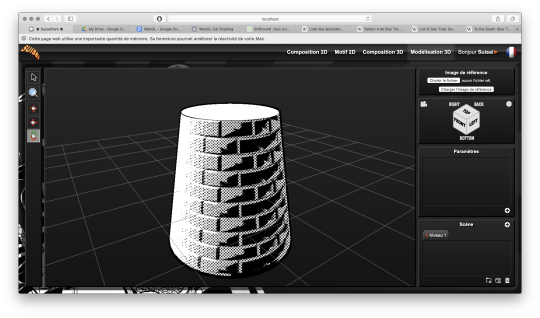
Péguy
Hi everybody! In this news feed I've told you a few times about a project I named Péguy. Well today I dedicate a complete article to it to present it to you in more detail but also to show you the new features I brought to it at the beginning of the winter. It's not the priority project (right now it's TGCM Comics) but I needed a little break during the holidays and coding vector graphics and 3D, it's a little bit addictive like playing Lego. x) Let's go then!
Péguy, what is it?
It is a procedural generator of patterns, graphic effects and other scenery elements to speed up the realization of my drawings for my comics. Basically, I enter a few parameters, click on a button, and my program generates a more or less regular pattern on its own. The first lines of code were written in 2018 and since then, this tool has been constantly being enriched and helping me to work faster on my comics. :D This project is coded with web languages and generates vector patterns in the format SVG. In the beginning it was just small scripts that had to be modified directly to change the parameters and run individually for each effect or pattern generated.

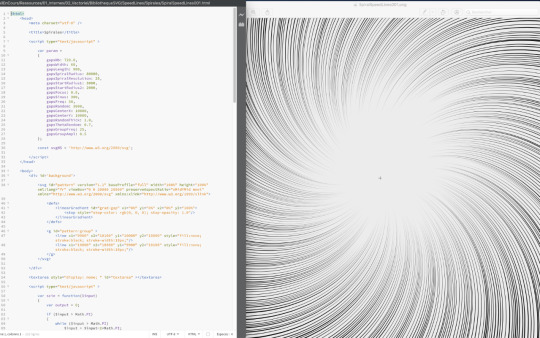
Not very user friendly, is it? :’D
This first version was used on episode 2 of Dragon Cat's Galaxia 1/2. During 2019 I thought it would be more practical to gather all these scripts and integrate them into a graphical user interface. Since then, I have enriched it with new features and improved its ergonomics to save more and more time. Here is a small sample of what can be produced with Péguy currently.
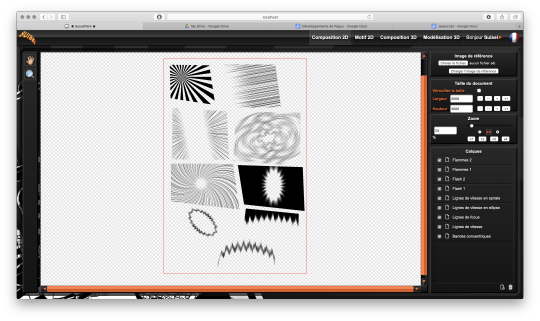
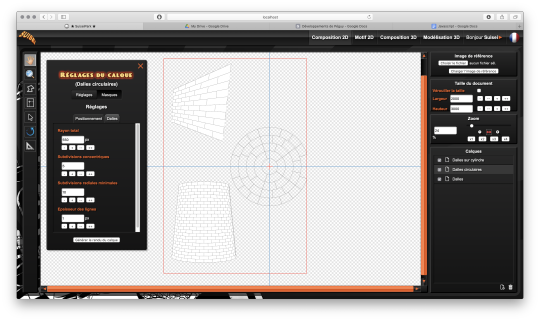
Graphic effects typical of manga and paving patterns in perspective or plated on a cylinder. All these features were used on Tarkhan and Gonakin. I plan to put this project online, but in order for it to be usable by others than me, I still need to fix a few ergonomy issues. For the moment, to recover the rendering, you still need to open the browser debugger to find and copy the HTML node that contains the SVG. In other words, if you don't know the HTML structure by heart, it's not practical. 8D
A 3D module!
The 2020 new feature is that I started to develop a 3D module. The idea, in the long run, is to be able to build my comics backgrounds, at least the architectural ones, a bit like a Lego game. The interface is really still under development, a lot of things are missing, but basically it's going to look like this.
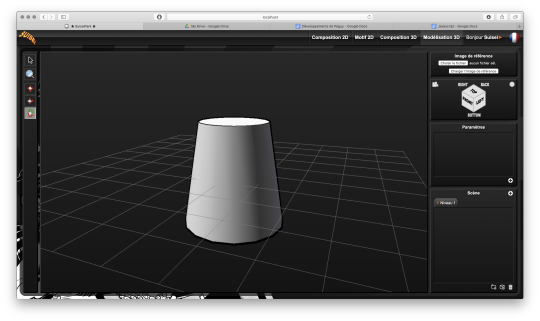
So there's no shortage of 3D modeling software, so why am I making one? What will make my project stand out from what already exists? First, navigation around the 3D workspace. In short, the movement of the camera. Well please excuse me, but in Blender, Maya, Sketchup and so on, to be able to frame according to your needs to get a rendering, it's just a pain in the ass! So I developed a more practical camera navigation system depending on whether you're modeling an object or placing it in a map. The idea is to take inspiration from the map editors in some video games (like Age of Empire). Secondly, I'm going to propose a small innovation. When you model an object in Blender or something else, it will always be frozen and if you use it several times in an environment, it will be strictly identical, which can be annoying for natural elements like trees for example. So I'm going to develop a kind of little "language" that will allow you to make an object customizable and incorporate random components. Thus, with a single definition for an object, we can obtain an infinite number of different instances, with random components for natural elements and variables such as the number of floors for a building. I had already developed a prototype of this system many years ago in Java. I'm going to retrieve it and adapt it to Javascript. And the last peculiarity will be in the proposed renderings. As this is about making comics (especially in black and white in my case), I'm developing a whole bunch of shaders to generate lines, screentones and other hatchings automatically with the possibility to use patterns generated in the existing vector module as textures! :D
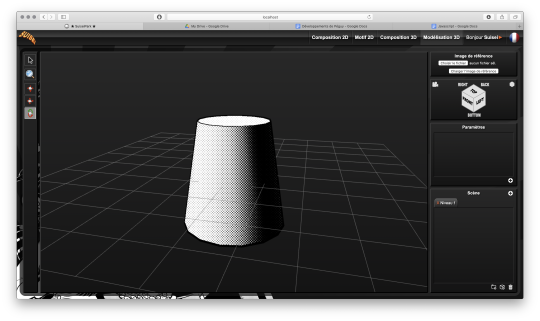

What are shaders?
Well, you see the principle of post-production in cinema... (Editing, sound effects, various corrections, special effects... all the finishing work after shooting). Well, shaders are about the same principle. They are programs executed just after the calculation of the 3D object as it should appear on the screen. They allow to apply patches, deformations, effects, filters... As long as you are not angry with mathematics, there is only limit to your imagination! :D When you enter a normal vector in a color variable it gives funny results.
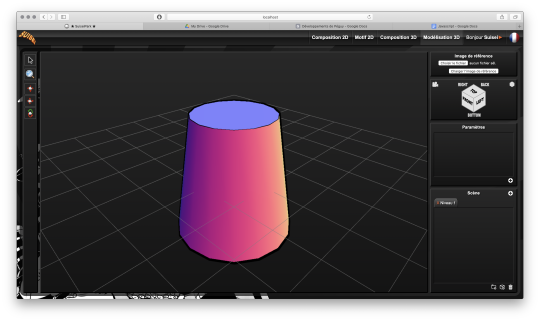
Yes! It's really with math that you can display all these things. :D Now when you hear a smart guy tell you that math is cold, it's the opposite of art or incompatible with art... it's dry toast, you'll know it's ignorance. :p Math is a tool just like the brush, it's all about knowing how to use it. :D In truth, science is a representation of reality in the same way as a painting. It is photorealistic in the extreme, but it is nevertheless a human construction used to describe nature. It remains an approximation of reality that continually escapes us and we try to fill in the margins of error over the centuries... Just like classical painting did. But by the way? Aren't there a bunch of great painters who were also scholars, mathematicians? Yes, there are! Look hard! The Renaissance is a good breeding ground. x) In short! Physics is a painting and mathematics is its brush. But in painting, we don't only do figurative, not only realism, we can give free rein to our inspiration to stylize our representation of the world or make it abstract. Well like any good brush, mathematics allows the same fantasy! All it takes is a little imagination for that. Hold, for example, the good old Spirograph from our childhood. We all had one! Well, these pretty patterns drawn with the bic are nothing else than... parametric equations that make the students of math sup/math spe suffer. 8D Even the famous celtic triskelion can be calculated from parametric equations. Well, I digress, I digress, but let's get back to our shaders. Since you can do whatever you want with it, I worked on typical manga effects. By combining the Dot Pattern Generator and the Hatch Generator but display them in white, I was able to simulate a scratch effect on screentones.

In the traditional way it is an effect that is obtained by scraping the screentones with a cutter or similar tool.

Péguy will therefore be able to calculate this effect alone on a 3D scene. :D I extended this effect with a pattern calculated in SVG. So it will be possible to use the patterns created in the vector module as textures for the 3D module! Here it is a pattern of dots distributed according to a Fibonacci spiral (I used a similar pattern in Tarkhan to make stone textures, very commonly used in manga).
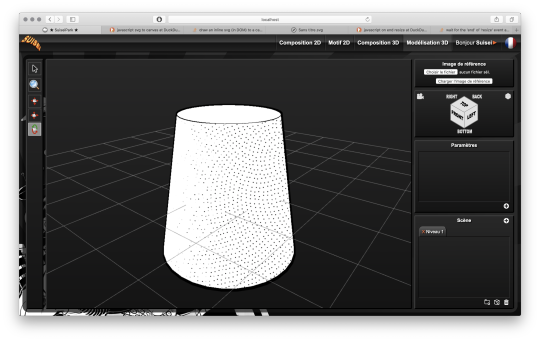
Bump mapping
So this is where things get really interesting. We stay in the shaders but we're going to give an extra dimension to our rendering. Basically, bump mapping consists in creating a bas-relief effect from a high map. And it gives this kind of result.
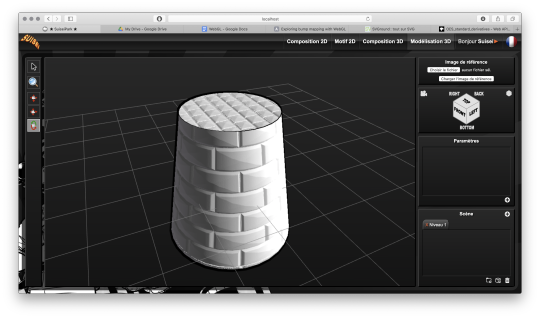
The defined object is always a simple cylinder (with 2 radii). It is the shaders that apply the pixel shift and recalculate the lighting thanks to the high map that looks like this.

This texture has also been calculated automatically in SVG. Thus we can dynamically set the number of bricks. Well, this bas-relief story is very nice, but here we have a relatively realistic lighting, and we would like it to look like a drawing. So by applying a threshold to have an area lit in white, a second threshold to have shadow areas in black, by applying the screentone pattern to the rest and by adding the hatching that simulates the scraped screentone, here is the result!

It's like a manga from the 80's! :D I tested this rendering with other screentone patterns: Fibonnacci spiral dots, parallel lines or lines that follow the shape of the object.

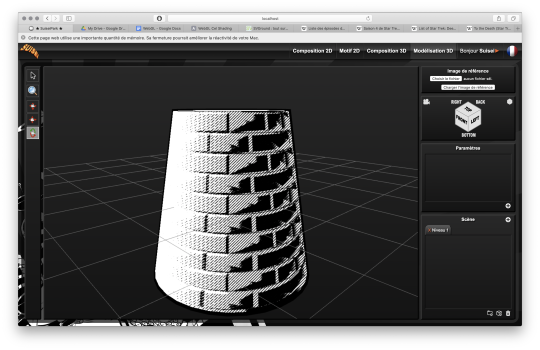
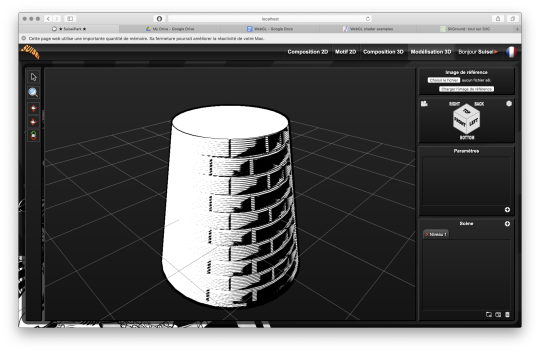
Now we know what Péguy can do. I think I can enrich this rendering a bit more with the shaders but the next time I work on this project the biggest part of the job will be to create what we call primitives, basic geometric objects. After that I can start assembling them. The concept of drawing while coding is so much fun that I'm starting to think about trying to make complete illustrations like this or making the backgrounds for some comic book projects only with Péguy just for the artistic process. Finding tricks to generate organic objects, especially plants should be fun too. That's all for today. Next time we'll talk about drawing! Have a nice week-end and see you soon! :D Suisei
P.S. If you want miss no news and if you haven't already done so, you can subscribe to the newsletter here : https://www.suiseipark.com/User/SubscribeNewsletter/language/english/
Source : https://www.suiseipark.com/News/Entry/id/302/
1 note
·
View note
Text
Introducing Predictor 2020!
It’s New, Improved, and Better Than Ever (Part 1)

The Predictor is Duggar Data’s favorite forecasting tool. It’s a massive Excel workbook, written by yours truly, that tracks all of the data—i.e., dates—about relationships and pregnancies, crunches that data, and then plugs all of the data into an algorithm to predict future events. Predictor 1.0 hit the scene almost 2 Years Ago... Since then, I’ve improved it several times, but Predictor 2020 is by far the most significant revision. Honestly, it’s a total rebuild, which incorporates more data than ever before, tweaks the algorithm to hopefully be more accurate and realistic, and allow for future expansion. (Now, I can easily add new families, or make specific predictions for the 4th Generation!)
Here’s a quick overview of Predictor 2020—what’s the same, what’s different. Part 1 focuses on what’s the same. Part 2 focuses on what’s changed.
What’s The Same—
Like all Predictors, Predictor 2020 creates personal forecasts for each Duggar, Bates, Maxwell, etc., based on data from that individual and their family.
Like previous versions, Predictor 2020 is fueled by Averages (AKA Means) and Standard Deviations (SDs). Average (or Mean) is a measure of typicality, which identifies a specified value as the most ‘ordinary’ value within a given data set. It’s calculated with the formula: Average = (Sum of All Data Points) / (# of Data Points). While all sorts of fancy means exist in statistics, Duggar Data uses an ordinary arithmetic mean for all purposes. (I don’t claim to be very statistically rigorous!) Standard Deviation (SD) is the other data type used in the Predictor, and comes into play whenever an event is ‘late.’ SD is a measure of variability, which uses a single value to represent how consistent data points are within a specified data set. If you’re nostalgic for your high school statistics class, you can read all about the SD formula here.
Predictor 2020, and all the previous versions, are also chronological. By this, I mean that each event builds on the next. For individuals with no data to speak of—e.g., Josie Duggar, who is far too young to be in a relationship—it starts by calculating a Courtposal Date. Then, it calculates a Proposal Date, assuming a Duggar–average length courtship. A Duggar–average length engagement adds onto that, and you get a projected Wedding Date, which is adjusted to a nearby Friday or Saturday, if needed, etc., etc.
Here’s a brief summary of how Predictor 2020 calculates each date—
Courtship Start Date is based on age, and is sex specific. Females will start courting at their family’s Average Age at C.S. for Females (Born–In and In–Laws), and males will start courting at their family’s Average Age at C.S. for Males (Born–In and In–Laws).
Engagement Date = Courtship Start Date + Average Length Courtship, with average length being calculated from the relevant family’s data.
Wedding Date = Engagement Date + Average Length Engagement, per the relevant family’s data. If necessary, the date is then slightly adjusted to fall on the closest Friday or Saturday.
Pregnancy Announcement #1 = Wedding Date + Average Marriage–to–Firstborn Spacing – Average Timing of Birth (vs. Due Date) – (280 – Mean Timing of Pregnancy Announcement), all based on family data.
DOB of Child #1 = Wedding Date + Average Marriage–to–Firstborn
Subsequent Pregnancy Announcement = Last Birth + Average Spacing Between Births – Average Timing of Birth (vs. Due Date) – (280 – Average Timing of Pregnancy Announcements), all based on the specific couple’s data (if available) or the relevant family’s data (Duggar, Bates, etc.)
Subsequent Children’s DOBs = Last Birth + Average Child Spacing
Fertility Cut–Off is based on the age at which a woman’s mother’s final child was born. Age 40 is used if Duggar Data can’t find information on the woman’s mother, her mother wasn’t quiverfull, or her mother hasn’t yet completed her own quiver and she’s still under Age 40.
Note that, when real data is available, the Predictor always uses that instead of it’s projection. So... The Predictor thought Katie + Travis would begin courting at a specific time, and based all subsequent events on that date. When Katie + Travis actually announced their courtship, I added the real date (or, in this case, my best estimate) in, and the Predictor recalculates everything based on that.
Additionally, with Children’s DOBs... Once a pregnancy is announced, the due date provided by the couple (or my best estimate) controls the projected DOB, not the longer formula listed above. Once there’s a know pregnancy, the DOB formula is quite simply: Due Date + Typical Timing of Birth (vs. Due Date).
Next up... What’s New + Improved for Predictor 2020!
14 notes
·
View notes
Text
Recalculation Implementations Enhanced for MPP & XML File Formats inside Java Apps
What’s new in this release?
Aspose team is pleased to announce the release of Aspose.Tasks for Java 17.3.0.This month’s release is kind of maintenance release where Aspose team has not only work hard to fix the bugs reported by the valued customers, but also made improvements in the overall API architecture for improved functionality. The bug fixes included in this month’s release affect a number of functionality areas of the API in terms of improvement. It has fixed issues related to reading and writing MPP files that resulted in exceptions while saving the file. It has also fixed issues related to the formula value calculations while working with date time formula fields of a project. The recalculation issues have been fixed for these fields including DateAdd, DateDiff and DatePart. It has also improved the recalculation implementations for both MPP and XML file formats. This includes bug fixes that resulted in unexpected output in some cases. Fixing such issues has improved the API behavior in terms of expected output for specified criterion. Below is the complete list of bug fixes and enhanced features included in this release.
Inconsistent behavior of %Complete in MPP
WBS Codes written to MPP file are not same as Microsoft Project
ArgumentOutOfRangeException is raised when setting task Finish date
Empty timephased data added in XML for type AssignmentWork (.NET)
Formula values not calculated properly for DateAdd, DateDiff and DatePart
Project reading exception while loading MPP file
Project Reading Exception while Loading MPP file
Newly added documentation pages and articles
Some new tips and articles have now been added into Aspose.Tasks for Java documentation that may guide users briefly how to use Aspose.Tasks for performing different tasks like the followings.
Extended Task Attributes
Writing Metadata to MPP
Overview: Aspose.Tasks for Java
Aspose.Tasks is a non-graphical Java Project management component that enables Java applications to read, write & manage Project documents without utilizing MS Project. It supports reading MS Project Template (MPT) files as well as allows exporting project data to HTML, BMP, PNG, JPEG, PDF, TIFF, XPS, XAML and SVG formats. It reads & writes MS Project documents in both MPP & XML formats. Developers can read & change tasks, recurring tasks, resources, resource assignments, relations & calendars.
More about Aspose.Tasks for Java
Homepage of Aspose.Tasks for Java
Download Aspose.Tasks for Java
#reading MPP files enhanced#writing to MPP files#formula value calculations#working with date time formula#Improved Project Recalculation#Java Project management API
0 notes